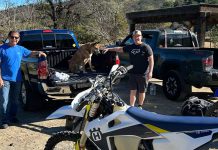Just over a week ago, the navy arrived in a foreign land with a
devastated infrastructure and seized upon a mission with one
directive: Provide assistance to those in need. Beyond this one
simple order, the architecture and support for this mission was
created as each aircraft departed for its destination.
Just over a week ago, the navy arrived in a foreign land with a devastated infrastructure and seized upon a mission with one directive: Provide assistance to those in need. Beyond this one simple order, the architecture and support for this mission was created as each aircraft departed for its destination.
With multiple lessons learned, missed opportunities and the unknown lurking just beyond the next sunrise, we end each day determining how to make our mission more efficient. This being said, there is still ample opportunity to seek out and assist the remote villages we are finding. Thousands still need food and water and many more require medical help.
With the arrival of the Australians also comes a rudimentary form of air traffic control. The Australian Air Force erected a crude tower and placed two or three controllers in it to monitor helicopter traffic. All naval helicopter activity has been relegated to a soccer field adjacent to the airfield itself and deconfliction amongst all the other aircrafts is a veritable puzzle in the sky. The Australians have become adept at coordinating and managing this puzzle but they rely on our voice communications and what their eyes can see.
As day breaks we begin our ritual of preparation and briefing. With a large steaming cup of coffee in hand, one of the first questions that are fielded will ultimately be how much sleep the crew managed to get. The answer is always plenty but from the yawns and drawn eyes we all know that a few hours at best is the truth.
Fuel is a concern, distance to and from the staging area at Banda Aceh direct to our drop points, weight, and the looming menace of bad weather are the most important factors of these flights.
We start the aircraft just as the day starts with the sun breaking the horizon.
Today we will fly in the first of the navy working party that has been assembled. We will typically make about three runs back and forth between the airfield and the aircraft carrier before we have transported all personnel. For the next 14-16 hours these men and women will manually unload supplies from waiting trucks, form a massive line and heave supplies aboard our helicopters. Today is especially miserable as the rain has already begun and the forecast predicts heavy rain showers throughout the day.
Our supplies today consist of 100 pound bags of rice, ramen and 5 gallon jugs of water. We are able to take 2000 pounds of cargo at a time because we are still relatively full of fuel.
Once we have loaded the cargo, the moist bags of rice begin to fill the cabin with a pungent smell like they have been cooking and fermenting.
We take off and depart towards the coastline.
Today we are headed to Chalang which has become quite a gathering point for refugees. It is located roughly midway between the 110 miles of coastline we service and it seems that those who travel the road either in a northerly or southerly direction will eventually find their way here. The Indonesian Army has set up an operation in Chalang complete with medical tents, food storage and distribution, and a shipboard evacuation system.
Cleanup has also begun. There is heavy equipment collecting debris and waste. Piles are formed so that they may be burned. A back-ho digs a trench along the road to help with drainage and the mass grave to the south is covered with more dirt to help cover the smell of putrefying flesh.
Along the useable portions of road, jeeps and trucks travel to pick up the weary and transport them back to Chalang. Upon landing we see the activity and life in this refugee camp and it is a stark reminder that there are thousands with no homes to ever return to.
My commander decides to keep a few bags of rice and a few jugs of water for our return trip. Instead of dropping all our cargo where there seems to be an ample supply of food, we will instead keep some in order to drop it off to the people still clinging to life and hope along the road.
They are jubilant to be receiving something as evidenced by their rush into the path of our barely landed helicopter. Smiles and thumbs-ups are exchanged and we depart.









